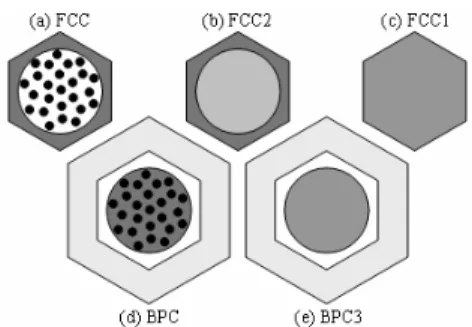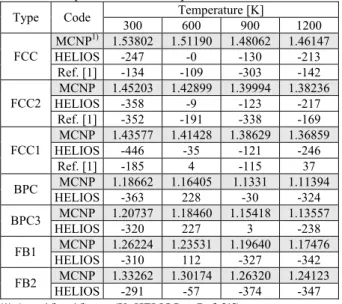Benchmark Calculation for GT-MHR using HELIOS/MASTER Code Package and MCNP
Kyung-Hoon Lee, Kang-Seog Kim, Jae-Man Noh, Jae-Seung Song, Sung-Quun ZeeKorea Atomic Energy Research Institute, P.O. Box 105, Yuseong, Daejeon, 305-600, Korea, lkh@kaeri.re.kr
1. Introduction
The latest research associated with the very high temperature gas-cooled reactor (VHTR) is focused on the verification of a system performance and safety under operating conditions for the VHTRs. As a part of those, an international gas-cooled reactor program initiated by IAEA is going on. The key objectives of this program are the validation of analytical computer codes and the evaluation of benchmark models for the projected and actual VHTRs. [1]
New reactor physics analysis procedure for the prismatic VHTR is under development by adopting the conventional two-step procedure. [2] In this procedure, a few group constants are generated through the transport lattice calculations using the HELIOS [3] code, and the core physics analysis is performed by the 3-dimensional nodal diffusion code MASTER [4].
We evaluated the performance of the HELIOS/MASTER code package through the benchmark calculations related to the GT-MHR (Gas Turbine-Modular Helium Reactor) to dispose weapon plutonium. [1] In parallel, MCNP is employed as a reference code to verify the results of the HELIOS/MASTER procedure.
2. Descriptions and Results
2.1 Benchmark Problems
Figure 1. MCNP model for the GT-MHR core The GT-MHR core shown in Figure 1 is constructed as an active core with radial, internal and axial reflectors. The active core is made of 102 columns of 800 cm height consisting of 10 hexahedral prismatic fuel blocks with a 36 cm pitch stacked axially. In the 30 columns, there is eccentrically a 13 cm diameter hole for control rods or a reserve shutdown system (RSS). The reflectors are the graphite block which is similar to the shape of the fuel block. The height of the radial and internal reflector is 1060 cm. The 36 radial reflector
columns contiguous with the core have a hole to accommodate the control rods.
Figure 2. Schematic presentation of pin cell models Benchmark problems include fuel cell models, burnable poison cell models and six different core models.
The fuel compact cell models include FCC, FCC2 and FCC1 as shown in Figure 2 (a), (b) and (c). FCC is made of fuel kernels (PuO1.7) with a four-layer coating
in the graphite matrix and the external zone of the graphite block. The packing fraction of TRISO in the matrix is 0.12978. FCC2 and FCC1 are to homogenize the TRISO and matrix, and all the materials, respectively.
The burnable poison cell models include BPC and BPC3 as shown in Figure 2 (d) and (e). BPC consists of Er2O3 particulates (packing fraction: 0.08636) randomly
dispersed in the graphite matrix, the intermediate zone of the graphite block and the external zone of the homogeneous mixture including the fuel, graphite block and helium. BPC3 is to homogenize the internal zone of the BPC.
The core calculation models as shown in Figure 1 are divided into six variants according to the axial arrangement of two different fuel blocks (FB1 and FB2) with four different fuel burnups. In addition, two simple core problems including all the fresh fuel blocks were constructed with (SC1) and without (SC2) Helium flow channels to observe the existence of a neutron streaming effect.
2.2 MCNP and HELIOS/MASTER Code Package Nuclear physics analysis for the VHTR developed at KAERI is composed of HELIOS, HOPE, PROLOG and MASTER as shown in Figure 3. At first, a double heterogeneity in a fuel compact is removed through the reactivity-equivalent physical transformation (RPT) [5] from the MCNP reference calculations. And then HELIOS performs a transport lattice calculation to generate a few group cross sections for each fuel block
Transactions of the Korean Nuclear Society Autumn Meeting Busan, Korea, October 27-28, 2005
and reflectors. HOPE and PROLOG process the HELIOS output to generate the functionalized cross section tableset. MASTER carries out a nodal diffusion calculation for the VHTR cores.
Figure 3. HELIOS/MASTER code package 2.3 Calculation Results
Pin cell and block calculations were performed at four different constant temperatures of 300, 600, 900 and 1200 K. Since HELIOS can not treat the double heterogeneous problem in FCC and BPC, the RPT method has been employed to transform it into a single heterogeneous one. The effective radius of a mixture of the fuel kernels and graphite matrix is estimated to conserve all the neutronic parameters including the eigenvalue and reaction rates compared to the reference MCNP results.
Table 1. Comparison of the multiplication factors
Temperature [K] Type Code 300 600 900 1200 MCNP1) 1.53802 1.51190 1.48062 1.46147 HELIOS -247 -0 -130 -213 FCC Ref. [1] -134 -109 -303 -142 MCNP 1.45203 1.42899 1.39994 1.38236 HELIOS -358 -9 -123 -217 FCC2 Ref. [1] -352 -191 -338 -169 MCNP 1.43577 1.41428 1.38629 1.36859 HELIOS -446 -35 -121 -246 FCC1 Ref. [1] -185 4 -115 37 MCNP 1.18662 1.16405 1.1331 1.11394 BPC HELIOS -363 228 -30 -324 MCNP 1.20737 1.18460 1.15418 1.13557 BPC3 HELIOS -320 227 3 -238 MCNP 1.26224 1.23531 1.19640 1.17476 FB1 HELIOS -310 112 -327 -342 MCNP 1.33262 1.30174 1.26320 1.24123 FB2 HELIOS -291 -57 -374 -347 ※ ∆ρX=1/kX–1/kMCNP (X=HELIOS or Ref. [1]) 1) Standard deviation < 0.00060
The calculational results for the cell, burnable poison and fuel block models are compared with those of the MCNP calculations and Ref. [1]. As shown in Table 1, the multiplication factors of HELIOS agree well with those of MCNP and Ref. [1] within the maximum error of 450 pcm for the pin cell, the burnable poison cell and the fuel block problems.
Various reaction rates and the depleted particle number densities of Erbium are also very consistent with each other.
Table 2. Comparison of the keff for core models at 300 K
Type Code keff Type Code keff
MCNP1) 1.28406 MCNP 1.23441 SC1 H/M2) 52 SC2 H/M 238 MCNP 1.18487 MCNP 1.13342 Variant1 H/M -232 Variant4 H/M -263 MCNP 1.11045 MCNP 1.16326 Variant2 H/M -454 Variant5 H/M -238 MCNP 1.19266 MCNP 1.09269 Variant3 H/M -181 Variant6 H/M -537 ※ ∆ρX=1/kX–1/kMCNP (X=H/M) 1) Standard deviation < 0.00050 2) HELIOS/MASTER
Table 2 shows the comparison of the multiplication factors for the core calculations using MCNP and HELIOS/MASTER for a simple core and six variant core models at 300 K. Prior to the MASTER calculation, we generated the 8-group macroscopic cross sections table-sets for three types of radial reflectors using the equivalence theory and two types of fuel blocks. Table 2 shows that the multiplication factors of MASTER are very consistent with the MCNP values within the maximum error of 540 pcm. Also, the radial and axial power distributions of MASTER are very consistent with those of MCNP.
3. Conclusion
GT/MHR Benchmark calculations were performed using the 2-step procedure of HELIOS/MASTER under development for the VHTR physics analysis.
Although there are still several problems to overcome, the calculational results show that the conventional 2-step procedure using the HELIOS/MASTER procedure can be applied to the VHTR physics analysis.
REFERENCES
[1] M. Methnani et al., “Evaluation of High Temperature Gas Cooled Reactor(HTGR) Performance,” IAEA-TECDOC-TBD, International Atomic Energy Agency (2004).
[2] K. S. Kim et al., “Two-step Procedure Development for VHTR physics analysis using 1-D Core Models,” (Submitted to 2005 KNS Fall Meeting)
[3] R. J. Stamml’er et al., “HELIOS Methods,” Studsvik Scandpower (1998)
[4] B. O. Cho, et al., “MASTER-2.0 : Multi-purpose Analyzer for Static and Transient Effects of Reactors,” KAERI/TR-1211/99 (1999)
[5] Y. H. Kim, et al., “Reactivity-Equivalent Physical Transformation for Homogenization of Double-Heterogeneous Fuels,” (Submitted to 2005 KNS Fall Meeting) HELIOS Library HOPE Output PROLOG HGC File MASTER XS Tableset

